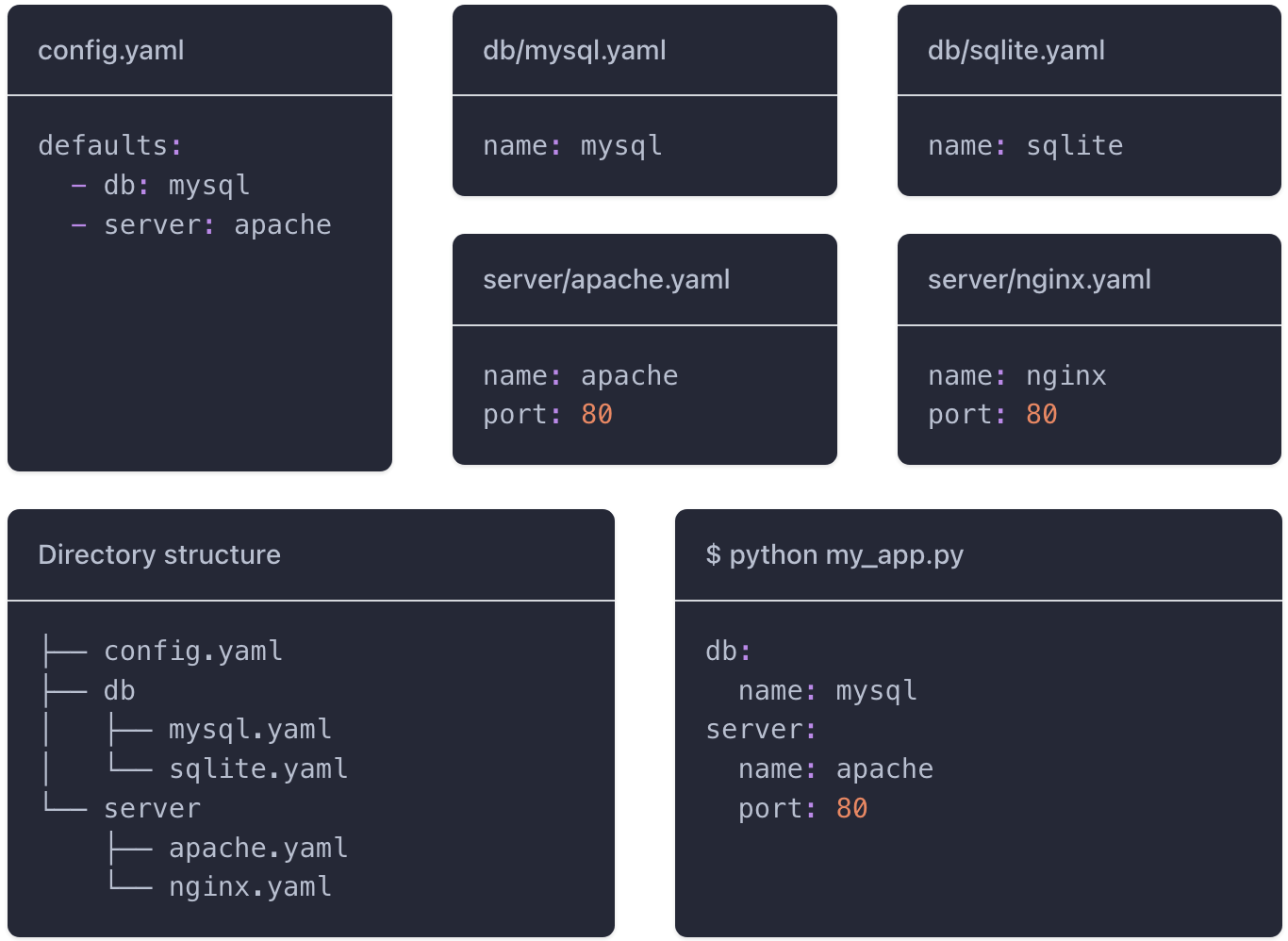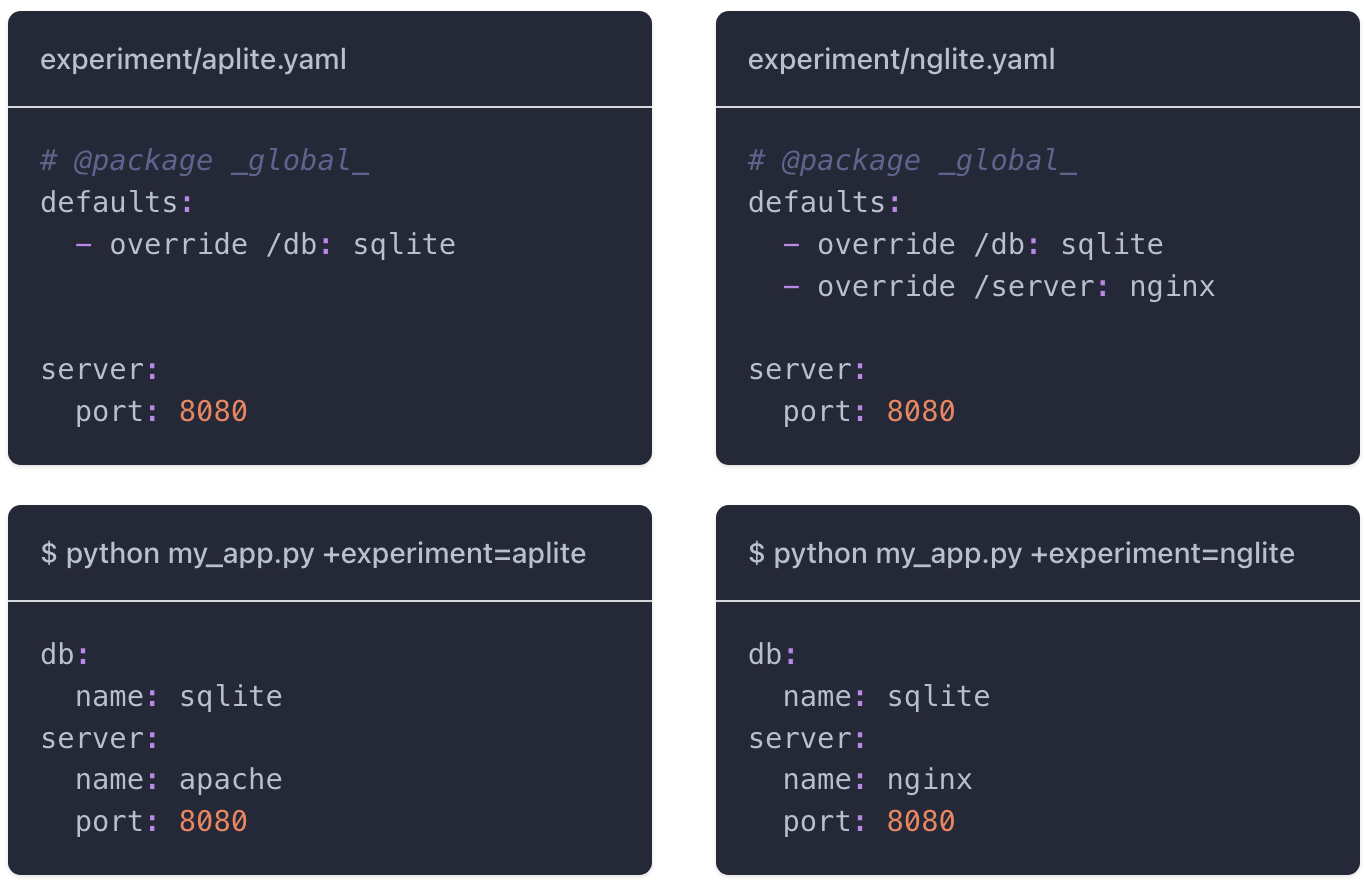Hydra: Advanced
Extend Configs
A common pattern is to extend an existing config, overriding and/or adding new config values to it. The extension is done by
including the base configuration, and then
overriding the chosen values in the current config.
Example: Extending a config from the same config group
config.yaml
defaults:
- db: mysql
db/mysql.yaml
defaults:
- base_mysql # We extend mysql on the base of base_mysql
user: omry
password: secret
port: 3307
encoding: utf8
db/base_mysql.yaml
host: localhost
port: 3306
user: ???
password: ???
$ python my_app.py
db:
host: localhost # from db/base_mysql
port: 3307 # overridden by db/mysql.yaml
user: omry # populated by db/mysql.yaml
password: secret # populated by db/mysql.yaml
encoding: utf8 # added by db/mysql.yaml
Configuring Experiments
To clearly support multiple configurations, each configuration file only specifies the changes to the master (default) configuration.
Example:
The default configuration is:

The benchmark config files specify the deltas from the default configuration:

Key concepts:
# @package _global_
Changes specified in this config should be interpreted as relative to the_global_package.
We could instead place nglite.yaml and aplite.yaml next to config.yaml and omit this line.- The overrides of
/dband/serverare absolute paths.
This is necessary because they are outside of the experiment directory.
Running the experiments from the command line requires prefixing the experiment choice with a +.
$ python .\train.py +experiment=aplite
Sweeping over experiments
This approach also enables sweeping over those experiments:
$ python my_app.py --multirun +experiment=aplite,nglite
To run all the experiments, use the glob syntax:
$ python my_app.py --multirun '+experiment=glob(*)'
Specializing Configuration
In some cases the desired configuration should depend on other configuration choices.
Example:
You may want to use only 5 layers in your Alexnet model if the dataset of choice is cifar10, and the default 7 otherwise.
We can start with a config that looks like this:
# config.yaml
defaults:
- dataset: imagenet
- model: alexnet
We want to specialize the config based on the choice of the selected dataset and model.
OmegaConf supports value interpolation, we can construct a value that would - at runtime - be a function of other values. The idea is that we can add another element to the defaults list that would load a file name that depends on those two values.
Modify config.yaml:
defaults:
- dataset: imagenet
- model: alexnet
- optional dataset_model: ${dataset}_${model}
The key
dataset_modelis an arbitrary directory, it can be anything unique that makes sense, including nested directory likedataset/model.${dataset}_${model}is using OmegaConf’s variable interpolation syntax. At runtime, that value would resolve to imagenet_alexnet, or cifar_resnet - depending on the values ofdefaults.datasetanddefaults.model.optional: By default, Hydra fails with an error if a config specified in the defaults does not exist. In this case we only want to specialize cifar10 + alexnet, not all 4 combinations. the keywordoptionaltells Hydra to just continue if it can’t find this file.
Code example see: hydra/examples/patterns/specializing_config at main · facebookresearch/hydra · GitHub
Configuring Hydra
Hydra is highly configurable. Many of its aspects and subsystems can be configured, including:
- The Launcher
- The Sweeper
- Logging
- Output directory patterns
- Application help (–help and –hydra-help)
You can include some Hydra config snippet in your own config to override it directly, or compose in different configurations provided by plugins or by your own code. You can also override everything in Hydra from the command line just like with your own configuration.
Accessing the Hydra config
Hydra is passing to the function annotated by @hydra.main(). Two ways to access the Hydra config:
In your config, using the
hydraresolver:config_name: ${hydra:job.name}The resolver name is
hydra, and thekeyis passed after the colon.In code, using the
HydraConfigsingletonfrom hydra.core.hydra_config import HydraConfig @hydra.main() def my_app(cfg: DictConfig) -> None: print(HydraConfig.get().job.name)
The following variables are populated at runtime:
hydra.job: used for configuring some aspects of your job (more information see: Job Configuration)hydra.run: Used in single-run mode (i.e. when the--multiruncommand-line flag is omitted). See configuration for run.hydra.sweep: Used in multi-run mode (i.e. when the--multiruncommand-line flag is given) See configuration for multirun.hydra.runtime: Fields underhydra.runtimeare populated automatically and should NOT be overridden.hydra.overrides: Fields underhydra.overridesare populated automatically and should not be overridden.
For other fields that are present also at the top level of the Hydra Config see: Other Hydra settings.
Resolvers provided by Hydra
hydra: Interpolates into the
hydraconfig node. e.g. Use${hydra:job.name}to get the Hydra job name.now: Creates a string representing the current time using strftime. e.g. for formatting the time you can use something like
${now:%H-%M-%S}.python_version: Return a string representing the runtime python version by calling
sys.version_info. Takes an optional argument of a string with the values major, minor or macro. e.g:
Hydra + wandb
See: Configuring W&B Projects with Hydra